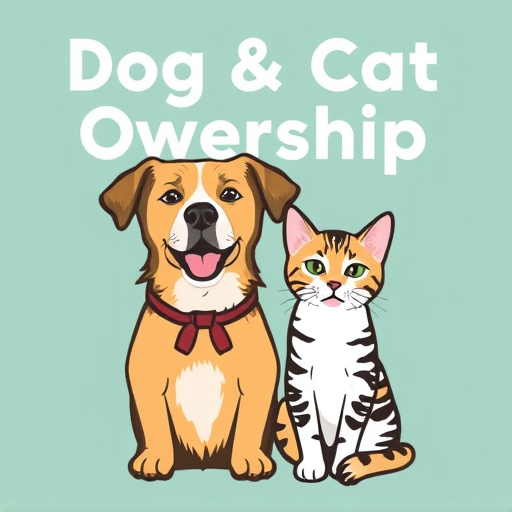Dog and cat ownership acts as a powerful social catalyst, fostering community building through shared spaces like dog parks and cat cafes. These pets encourage conversation and form friendships across diverse backgrounds, promoting a culture of care and empathy. Pet owners frequently interact at public spaces, leading to casual and structured social connections. Adoption or rescue fosters initial bonds with staff and fellow adopters, while regular pet activities facilitate neighbor interactions and create lasting friendships. This ultimately strengthens community ties through shared love for animals.
Caring for pets isn’t just about love and companionship; it’s a powerful catalyst for enhancing social connections. From building communities centered around shared interests like dog walks and cat playdates, to fostering conversations in public spaces, pet ownership creates opportunities for people to bond. This article explores the multifaceted role of dogs and cats in cultivating social networks, delving into community events, routine-building, and how these furry friends act as icebreakers, ultimately leading to lasting friendships.
- The Role of Pets in Building Communities
- – How pet owners interact with each other
- – Community events centered around pets
- – Pet adoption and rescue as social catalysts
The Role of Pets in Building Communities

Pets, especially dogs and cats, play a pivotal role in building and strengthening communities. They serve as common grounds that bring people together, fostering social connections where others might not exist. Dog parks and cat cafes are becoming increasingly popular gathering spaces where owners can interact, sharing stories and experiences with their furry friends. This sense of community extends beyond these specific locations, as pet owners often form informal networks based on shared interests and responsibilities.
Pet ownership encourages a culture of care and empathy, where individuals are more likely to engage in conversations, fostering new friendships and strengthening existing ones. Pets act as social catalysts, breaking down barriers and bridging gaps between people from diverse backgrounds. Whether it’s a casual chat while walking the dog or a shared moment of joy during a cat’s playful antics, these interactions contribute to a sense of belonging and can even lead to the formation of supportive social groups.
– How pet owners interact with each other

Pet ownership, whether it’s a dog or cat, often brings people together in unexpected ways. Pet owners tend to form strong bonds with one another due to their shared love and responsibility for animals. This fosters a sense of community, as they frequently interact at parks, pet stores, and vet clinics, creating opportunities for social connections. These interactions can range from casual conversations while walking dogs to more structured groups where cat or dog owners gather for training sessions or playdates.
Dog and cat ownership, in particular, has been shown to encourage social engagement. Pet owners are more likely to strike up conversations with strangers when their pets are present, a phenomenon often referred to as “pet-assisted socializing.” This can help combat loneliness, especially among seniors or individuals new to an area, as it provides a natural ice-breaker and opens doors to building new friendships.
– Community events centered around pets

In many communities, pet ownership has become a unifying force, fostering social connections and building stronger neighborhoods. Dog and cat owners often find themselves gathering at local parks or community centers for playgroups, training sessions, or simple walking meetups. These events encourage interaction among residents, creating opportunities for new friendships to bloom. The shared joy and responsibilities of pet parenting serve as a natural ice-breaker, making it easier for people from diverse backgrounds to connect and bond.
Moreover, these pet-centric gatherings can extend beyond the immediate neighborhood, organizing larger community events that attract folks from across town. Cat or dog shows, adoption drives, and fundraising walks/runs not only raise awareness about animal welfare but also bring people together in a fun and engaging manner. Such activities strengthen social fabric by creating a sense of collective purpose and responsibility, ultimately enriching the lives of both pets and their owners.
– Pet adoption and rescue as social catalysts

Adopting or rescuing a pet, whether it’s a dog or a cat, can serve as a powerful catalyst for social connections. The process itself often involves interactions with shelter staff, fellow adopters, and even other pet owners at adoption events, fostering initial social bonds. Once the pet is welcomed into the home, regular walks, visits to pet-friendly spaces, and playdates create opportunities to meet and connect with neighbors, fellow dog or cat enthusiasts, and potential friends.
Pet ownership also facilitates conversations and shared interests, breaking ice and building connections between individuals who might otherwise not have interacted. Dog owners, for instance, often form strong bonds while waiting in line at the vet or during playgroup sessions, leading to lasting friendships centered around their common love for animals. This social aspect of pet care adds a layer of joy and companionship to both the owner’s and the pet’s lives, strengthening community ties.
Pet ownership, whether it’s a dog or cat, serves as a powerful connector in communities. It encourages interactions between neighbors, fosters social events centered around our furry friends, and even plays a significant role in rescue efforts. By embracing pet ownership, individuals not only gain a companion but also contribute to building stronger, more connected neighborhoods. So, whether you’re out on a walk with your pooch or attending a cat-themed community gathering, remember that these moments are more than just enjoyable—they’re stepping stones to enhanced social connections.
